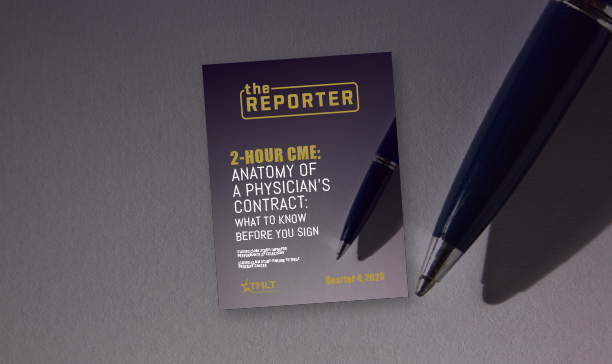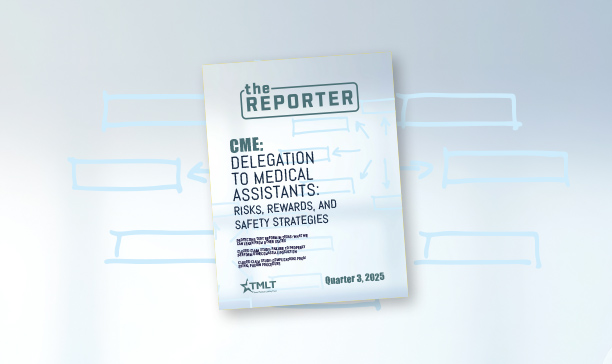Protecting tort reform in Texas: What we can learn from other states
Matthew Parr, TMLT's VP & General Counsel, describes how monitoring legislative protections in other states has benefited Texas and tort reform.
A mantra at TMLT heard regularly in organizational meetings is, “TMLT is here to protect Texas physicians.”
However, protecting Texas physicians precipitates not only a focus on Texas issues and, specifically, tort reform, but also a healthy understanding of legislative protections in other states and how these protections are currently being attacked and successfully defended.
First, it is important to remember the safeguards that tort reform provide to physicians in our state. The story of Texas medical professional liability tort reform has been outlined many times. But in a nutshell, Texas physicians, liability insurers, and attorneys, aligned in the late 1990s through the Texas Alliance for Patient Access (TAPA) to respond to a growing medical liability emergency of rising settlements, insurance premiums, and other costs.
United through TAPA, they developed the tort reform proposals that were eventually passed in 2003 as part of House Bill 4 (HB4). The constitutionality of the reforms was approved and memorialized by Texas voters later that same year with the passage of Proposition 12. A more detailed retelling of those events can be read in 20 Years of Texas Tort Reform.
The hallmark protections of HB4 as passed were:
- $250,000 non-economic damage cap;
- required advance notice of intent to file a health care liability claim;
- willful and wanton negligence standard for emergency services;
- requirement to provide expert reports from qualified experts within 120 days of filing the claim; and
- allowance for future periodic payments of future economic damages. (1)
Texas has maintained these protections since their passage in 2003, providing physicians with a beneficial level of claim, premium, and cost consistency for more than 20 years. While we see Texas as the “gold standard” of medical professional liability tort reform, Texas certainly was not the first state to enact protections.
Each state has its own unique story of its pursuit of and attempts to preserve tort reform. By examining the experiences of other states, we learn that tort reform is not invulnerable. Attempts to reverse tort reform efforts continue and maintaining current protections requires focus and diligence.
Legislative challenges
The story of tort reform generally begins in California.
In the 1970s, California was in the midst of its own health care liability emergency. The rising frequency and cost of medical liability claims led to rapidly increasing professional liability insurance premiums for California physicians — a situation soon mirrored in Texas. (2)
In response, the California legislature enacted the Medical Injury Compensation Reform Act, or MICRA, in 1975. Like Texas’ tort reform, MICRA included protections such as:
- $250,000 non-economic damage cap (3);
- required advanced notice of the intent to file a claim (4); and
- allowance for periodic payments of future economic damages. (5)
Since its passage, there have been efforts to overturn or amend MICRA through the courts and through the democratic process. However, the California Supreme Court ruled that the protections did not violate the California Constitution. (2) Additionally, a ballot initiative seeking to repeal MICRA failed to gain the approval of voters in 2014. (6)
Another ballot initiative threatened to eliminate the MICRA protections in 2022. (7) To guard against the possibility of voters passing this initiative, California stakeholders (including organized medicine, insurers, legislators, and attorneys) worked together to formulate legislation known as the MICRA Modernization Act. (8) Upon passage of this counter legislation, the 2022 ballot initiative was removed from the ballot.
The MICRA Modernization Act adjusted the MICRA protections in multiple ways, but its main change was to the non-economic damage cap. According to the new law, the cap on non-economic damage began to increase each year, starting January 1, 2023, according to a 10-year schedule.
Over the 10-year period, the cap will increase from $250,000 in 2023 to $750,000 in 2033, after which a two percent (2%) inflationary adjustment will occur every year. Currently, the base non-economic damage cap under the amended MICRA is $430,000. (3) Additionally, the Act created different cap categories which also incrementally increase according to a prescribed schedule. (9)
California’s non-economic damage cap, once the most longstanding damage cap in the nation, is now almost $200,000 higher than it was three years ago and will continue to rise.
California is not the latest state to increase its non-economic damage cap. Colorado and Nevada have passed legislation since the MICRA amendment that adjusts the non-economic caps in those states much like what was accomplished in California. (10, 11) There are now a handful of states that have regularly increasing non-economic damage caps in medical professional liability actions.
Judicial challenges
While states like California, Colorado, Nevada, and others have taken to adjusting enacted noneconomic damage caps through legislative action, caps in other states have been invalidated through the courts. Oklahoma, Kansas, and Oregon are three of the latest examples of these types of challenges.
Oklahoma
In 2011, Oklahoma legislators voted to enact liability protections that included a $350,000 cap on non-economic damages. The cap was in effect until 2019 when the Oklahoma Supreme Court ruled that the cap, as enacted, was unconstitutional. (12)
The underlying case involved a $15 million jury award to an injured individual which was reduced by more than $6 million through application of the cap. The court, in its reasoning, stated that the cap only capped damages for a specific class of claimants — those who did not die; thus, the cap was not allowed by the Oklahoma constitution because it failed to treat all possible claimants equally. (12) Despite this ruling, the Oklahoma legislature passed a new attempt at modified damage caps that went into effect on September 1, 2025. (13)
Kansas
Kansas initially passed its statute containing its non-economic damage cap in 1988. (14) The cap was first challenged in the Kansas Supreme Court in 2012. The court in 2012 upheld the statute and stated that the cap did not violate the Kansas Constitution’s right to a jury trial. However, in 2019 — just seven years later — the court ruled that the non-economic damage cap did violate that right and ruled that the non-economic damage cap was unconstitutional. (15)
Oregon
One year later in 2020, the Oregon Supreme Court struck down its state’s non-economic damage caps. With this decision, the Oregon Supreme Court provided final guidance on the applicability and constitutionality of a law that was originally passed in 1987. The court distinguished between injury claims and death claims and noted that, while a damage cap in wrongful death claims was allowable, non-economic damage caps for injured plaintiffs violated the Oregon constitution. (16)
The examples above show that there are multiple ways non-economic damage caps are being attacked by those who would seek their removal. It is important to note that California (1975), Oregon (1987), and Kansas (1988) all had medical malpractice protections in place that pre-dated the passage of Texas HB4.
Texas tort reforms today
To date, Texas has successfully maintained its protections despite recent legislative efforts to increase the non-economic damage caps. The most recent challenge presented during the 2024 legislative session. However, despite recent successes at defeating these challenges, indications here and in other states show that more opposition can be expected in the future. Any drop in focus or effort to properly frame the importance of our reforms, or failure to educate our new legislators on how the reforms benefit all Texans, could see the challenges become more difficult to block.
The good news for Texas physicians is that the constitutionality of caps in Texas is ensured, thanks to the passage of the constitutional amendment in Proposition 12 in 2003. Furthermore, TAPA, under the leadership of Brian Jackson, continues to give full focus to combatting legislative and judicial attacks on the Texas caps.
As TAPA’s name — the Texas Alliance for Patient Access — suggests, the cap is in place for the benefit of all Texans. A medical liability environment that is free from frivolous claims and lawsuits is one in which the insurance costs of maintaining a medical practice remain low. Fewer claims and lawsuits have led to lower insurance premiums, which makes it easier and more attractive to maintain a practice in Texas.
Such an environment ultimately leads to a larger number of physicians being available and accessible to patients. The reasons for the caps and the benefits that they provide to Texans are as valid today as they were in 2003.
The stories and experiences of other states provide Texas physicians with important context to highlight the value of these protections and why we must never forget their importance.
Sources
- See HB4, 78th R.S., Article 10 (Texas, 2003), available at Legislative Reference Library of Texas lrl.texas.gov/legis/billsearch.
- Marcelis R. Medical Injury Compensation Reform Act of 1975: Looking Back, Looking Forward, an Interview with Tort Reform Attorney, Fred Hiestand, General Counsel of Civil Justice Association of California, Business Law Journal, UC Davis School of Law. February 2012. Available at https://blj.ucdavis.edu/archives/11/1/medical-injury-compensation-reform-act-1975-looking-back-looking-forward-interview. Accessed July 29, 2025.
- California Code, Civil Code – CIV § 3333.2. Current as of January 1, 2023. Available at https://codes.findlaw.com/ca/civil-code/civ-sect-3333-2/. Accessed July 29, 2025.
- California Code, Code of Civil Procedure – CCP § 364. Current as of January 1, 2023. Available at https://codes.findlaw.com/ca/code-of-civil-procedure/ccp-sect-364/. Accessed July 29, 2025.
- California Code, Code of Civil Procedure - CCP § 667.7 (2021). Current as of January 1, 2023. Available at https://codes.findlaw.com/ca/code-of-civil-procedure/ccp-sect-667-7/. Accessed July 29, 2025.
- California Proposition 46, Medical Malpractice Lawsuit Cap and Drug Testing of Doctors Initiative (2014). Ballotpedia. Available at https://ballotpedia.org/California_Proposition_46,_Medical_Malpractice_Lawsuit_Cap_and_Drug_Testing_of_Doctors_Initiative_(2014). Accessed July 29, 2025.
- Henry TA. California’s MICRA law modernized after nearly 50 years, AMA. June 7, 2022. Available at https://www.ama-assn.org/practice-management/sustainability/california-s-micra-law-modernized-after-nearly-50-years. Accessed July 29, 2025.
- Wailes RE. MICRA 2022: A Sustained Era of Stability. California Medical Association. Available at https://www.cmadocs.org/micra2022. Accessed July 29, 2025.
- Claims involving a patient’s death were given an increased cap of $500,000 in 2023 which will increase to $1,000,000 over the next ten years and will be subject to the same inflationary adjustment thereafter. Currently this cap is $600,000. See source 3.
- Colorado General Assembly. SB24-130. 2024 Regular Session. Courts and Judicial. Noneconomic Damages Cap Medical Practice Actions. Available at https://leg.colorado.gov/bills/sb24-130. Accessed July 29, 2025.
- 2024 Nevada Revised Statutes. Chapter 41A - Actions for Professional Negligence. NRS 41A.035 - Limitation on amount of award for noneconomic damages; publication of amount of limitation by Nevada Supreme Court. Justia U.S. Law. Available at https://law.justia.com/codes/nevada/chapter-41a/statute-41a-035/. Accessed July 29, 2025.
- Beason v. I.E. Miller Services, Inc. Oklahoma Supreme Court Decisions, 2019. Available at https://law.justia.com/cases/oklahoma/supreme-court/2019/114301.html. Accessed July 29, 2025.
- Denwalt D. Oklahoma restores cap on ‘pain and suffering’ awards in injury lawsuits. The Oklahoman. June 7, 2025. Available at https://www.oklahoman.com/story/news/politics/courts/2025/06/07/oklahoma-injury-lawsuits-tort-reform-cap-for-pain-and-suffering/84049199007/. Accessed July 29, 2025.
- Miller v. Johnson, 289 P.3d. 1098 (Kan. 2012). Available at https://case-law.vlex.com/vid/miller-v-johnson-no-887744786. Accessed July 29, 2025
- Hilburn v. Enerpipe Ltd., 442 P.3d 509 (Kan. 2019). Available at https://law.justia.com/cases/kansas/supreme-court/2019/112765.html. Accessed July 29, 2025.
- Busch v. McInnis Waste Systems, 468 P.3d 419 (Or. 2020). Available at https://law.justia.com/cases/oregon/supreme-court/2020/s066098.html. Accessed July 29, 2025.
Disclaimer
A mantra at TMLT heard regularly in organizational meetings is, “TMLT is here to protect Texas physicians.”
However, protecting Texas physicians precipitates not only a focus on Texas issues and, specifically, tort reform, but also a healthy understanding of legislative protections in other states and how these protections are currently being attacked and successfully defended.
First, it is important to remember the safeguards that tort reform provide to physicians in our state. The story of Texas medical professional liability tort reform has been outlined many times. But in a nutshell, Texas physicians, liability insurers, and attorneys, aligned in the late 1990s through the Texas Alliance for Patient Access (TAPA) to respond to a growing medical liability emergency of rising settlements, insurance premiums, and other costs.
United through TAPA, they developed the tort reform proposals that were eventually passed in 2003 as part of House Bill 4 (HB4). The constitutionality of the reforms was approved and memorialized by Texas voters later that same year with the passage of Proposition 12. A more detailed retelling of those events can be read in 20 Years of Texas Tort Reform.
The hallmark protections of HB4 as passed were:
- $250,000 non-economic damage cap;
- required advance notice of intent to file a health care liability claim;
- willful and wanton negligence standard for emergency services;
- requirement to provide expert reports from qualified experts within 120 days of filing the claim; and
- allowance for future periodic payments of future economic damages. (1)
Texas has maintained these protections since their passage in 2003, providing physicians with a beneficial level of claim, premium, and cost consistency for more than 20 years. While we see Texas as the “gold standard” of medical professional liability tort reform, Texas certainly was not the first state to enact protections.
Each state has its own unique story of its pursuit of and attempts to preserve tort reform. By examining the experiences of other states, we learn that tort reform is not invulnerable. Attempts to reverse tort reform efforts continue and maintaining current protections requires focus and diligence.
Legislative challenges
The story of tort reform generally begins in California.
In the 1970s, California was in the midst of its own health care liability emergency. The rising frequency and cost of medical liability claims led to rapidly increasing professional liability insurance premiums for California physicians — a situation soon mirrored in Texas. (2)
In response, the California legislature enacted the Medical Injury Compensation Reform Act, or MICRA, in 1975. Like Texas’ tort reform, MICRA included protections such as:
- $250,000 non-economic damage cap (3);
- required advanced notice of the intent to file a claim (4); and
- allowance for periodic payments of future economic damages. (5)
Since its passage, there have been efforts to overturn or amend MICRA through the courts and through the democratic process. However, the California Supreme Court ruled that the protections did not violate the California Constitution. (2) Additionally, a ballot initiative seeking to repeal MICRA failed to gain the approval of voters in 2014. (6)
Another ballot initiative threatened to eliminate the MICRA protections in 2022. (7) To guard against the possibility of voters passing this initiative, California stakeholders (including organized medicine, insurers, legislators, and attorneys) worked together to formulate legislation known as the MICRA Modernization Act. (8) Upon passage of this counter legislation, the 2022 ballot initiative was removed from the ballot.
The MICRA Modernization Act adjusted the MICRA protections in multiple ways, but its main change was to the non-economic damage cap. According to the new law, the cap on non-economic damage began to increase each year, starting January 1, 2023, according to a 10-year schedule.
Over the 10-year period, the cap will increase from $250,000 in 2023 to $750,000 in 2033, after which a two percent (2%) inflationary adjustment will occur every year. Currently, the base non-economic damage cap under the amended MICRA is $430,000. (3) Additionally, the Act created different cap categories which also incrementally increase according to a prescribed schedule. (9)
California’s non-economic damage cap, once the most longstanding damage cap in the nation, is now almost $200,000 higher than it was three years ago and will continue to rise.
California is not the latest state to increase its non-economic damage cap. Colorado and Nevada have passed legislation since the MICRA amendment that adjusts the non-economic caps in those states much like what was accomplished in California. (10, 11) There are now a handful of states that have regularly increasing non-economic damage caps in medical professional liability actions.
Judicial challenges
While states like California, Colorado, Nevada, and others have taken to adjusting enacted noneconomic damage caps through legislative action, caps in other states have been invalidated through the courts. Oklahoma, Kansas, and Oregon are three of the latest examples of these types of challenges.
Oklahoma
In 2011, Oklahoma legislators voted to enact liability protections that included a $350,000 cap on non-economic damages. The cap was in effect until 2019 when the Oklahoma Supreme Court ruled that the cap, as enacted, was unconstitutional. (12)
The underlying case involved a $15 million jury award to an injured individual which was reduced by more than $6 million through application of the cap. The court, in its reasoning, stated that the cap only capped damages for a specific class of claimants — those who did not die; thus, the cap was not allowed by the Oklahoma constitution because it failed to treat all possible claimants equally. (12) Despite this ruling, the Oklahoma legislature passed a new attempt at modified damage caps that went into effect on September 1, 2025. (13)
Kansas
Kansas initially passed its statute containing its non-economic damage cap in 1988. (14) The cap was first challenged in the Kansas Supreme Court in 2012. The court in 2012 upheld the statute and stated that the cap did not violate the Kansas Constitution’s right to a jury trial. However, in 2019 — just seven years later — the court ruled that the non-economic damage cap did violate that right and ruled that the non-economic damage cap was unconstitutional. (15)
Oregon
One year later in 2020, the Oregon Supreme Court struck down its state’s non-economic damage caps. With this decision, the Oregon Supreme Court provided final guidance on the applicability and constitutionality of a law that was originally passed in 1987. The court distinguished between injury claims and death claims and noted that, while a damage cap in wrongful death claims was allowable, non-economic damage caps for injured plaintiffs violated the Oregon constitution. (16)
The examples above show that there are multiple ways non-economic damage caps are being attacked by those who would seek their removal. It is important to note that California (1975), Oregon (1987), and Kansas (1988) all had medical malpractice protections in place that pre-dated the passage of Texas HB4.
Texas tort reforms today
To date, Texas has successfully maintained its protections despite recent legislative efforts to increase the non-economic damage caps. The most recent challenge presented during the 2024 legislative session. However, despite recent successes at defeating these challenges, indications here and in other states show that more opposition can be expected in the future. Any drop in focus or effort to properly frame the importance of our reforms, or failure to educate our new legislators on how the reforms benefit all Texans, could see the challenges become more difficult to block.
The good news for Texas physicians is that the constitutionality of caps in Texas is ensured, thanks to the passage of the constitutional amendment in Proposition 12 in 2003. Furthermore, TAPA, under the leadership of Brian Jackson, continues to give full focus to combatting legislative and judicial attacks on the Texas caps.
As TAPA’s name — the Texas Alliance for Patient Access — suggests, the cap is in place for the benefit of all Texans. A medical liability environment that is free from frivolous claims and lawsuits is one in which the insurance costs of maintaining a medical practice remain low. Fewer claims and lawsuits have led to lower insurance premiums, which makes it easier and more attractive to maintain a practice in Texas.
Such an environment ultimately leads to a larger number of physicians being available and accessible to patients. The reasons for the caps and the benefits that they provide to Texans are as valid today as they were in 2003.
The stories and experiences of other states provide Texas physicians with important context to highlight the value of these protections and why we must never forget their importance.
Sources
- See HB4, 78th R.S., Article 10 (Texas, 2003), available at Legislative Reference Library of Texas lrl.texas.gov/legis/billsearch.
- Marcelis R. Medical Injury Compensation Reform Act of 1975: Looking Back, Looking Forward, an Interview with Tort Reform Attorney, Fred Hiestand, General Counsel of Civil Justice Association of California, Business Law Journal, UC Davis School of Law. February 2012. Available at https://blj.ucdavis.edu/archives/11/1/medical-injury-compensation-reform-act-1975-looking-back-looking-forward-interview. Accessed July 29, 2025.
- California Code, Civil Code – CIV § 3333.2. Current as of January 1, 2023. Available at https://codes.findlaw.com/ca/civil-code/civ-sect-3333-2/. Accessed July 29, 2025.
- California Code, Code of Civil Procedure – CCP § 364. Current as of January 1, 2023. Available at https://codes.findlaw.com/ca/code-of-civil-procedure/ccp-sect-364/. Accessed July 29, 2025.
- California Code, Code of Civil Procedure - CCP § 667.7 (2021). Current as of January 1, 2023. Available at https://codes.findlaw.com/ca/code-of-civil-procedure/ccp-sect-667-7/. Accessed July 29, 2025.
- California Proposition 46, Medical Malpractice Lawsuit Cap and Drug Testing of Doctors Initiative (2014). Ballotpedia. Available at https://ballotpedia.org/California_Proposition_46,_Medical_Malpractice_Lawsuit_Cap_and_Drug_Testing_of_Doctors_Initiative_(2014). Accessed July 29, 2025.
- Henry TA. California’s MICRA law modernized after nearly 50 years, AMA. June 7, 2022. Available at https://www.ama-assn.org/practice-management/sustainability/california-s-micra-law-modernized-after-nearly-50-years. Accessed July 29, 2025.
- Wailes RE. MICRA 2022: A Sustained Era of Stability. California Medical Association. Available at https://www.cmadocs.org/micra2022. Accessed July 29, 2025.
- Claims involving a patient’s death were given an increased cap of $500,000 in 2023 which will increase to $1,000,000 over the next ten years and will be subject to the same inflationary adjustment thereafter. Currently this cap is $600,000. See source 3.
- Colorado General Assembly. SB24-130. 2024 Regular Session. Courts and Judicial. Noneconomic Damages Cap Medical Practice Actions. Available at https://leg.colorado.gov/bills/sb24-130. Accessed July 29, 2025.
- 2024 Nevada Revised Statutes. Chapter 41A - Actions for Professional Negligence. NRS 41A.035 - Limitation on amount of award for noneconomic damages; publication of amount of limitation by Nevada Supreme Court. Justia U.S. Law. Available at https://law.justia.com/codes/nevada/chapter-41a/statute-41a-035/. Accessed July 29, 2025.
- Beason v. I.E. Miller Services, Inc. Oklahoma Supreme Court Decisions, 2019. Available at https://law.justia.com/cases/oklahoma/supreme-court/2019/114301.html. Accessed July 29, 2025.
- Denwalt D. Oklahoma restores cap on ‘pain and suffering’ awards in injury lawsuits. The Oklahoman. June 7, 2025. Available at https://www.oklahoman.com/story/news/politics/courts/2025/06/07/oklahoma-injury-lawsuits-tort-reform-cap-for-pain-and-suffering/84049199007/. Accessed July 29, 2025.
- Miller v. Johnson, 289 P.3d. 1098 (Kan. 2012). Available at https://case-law.vlex.com/vid/miller-v-johnson-no-887744786. Accessed July 29, 2025
- Hilburn v. Enerpipe Ltd., 442 P.3d 509 (Kan. 2019). Available at https://law.justia.com/cases/kansas/supreme-court/2019/112765.html. Accessed July 29, 2025.
- Busch v. McInnis Waste Systems, 468 P.3d 419 (Or. 2020). Available at https://law.justia.com/cases/oregon/supreme-court/2020/s066098.html. Accessed July 29, 2025.
Disclaimer
Want to save this article for later?
Download the full issue as a PDF for future reference or to share with colleagues.
Subscribe to Case Closed to receive insights from resolved cases.
You’ll receive two closed claim studies every month. These closed claim studies are provided to help physicians improve patient safety and reduce potential liability risks that may arise when treating patients.
Related Resources
Discover more insights, stories, and resources to keep you informed and inspired.






